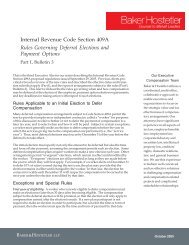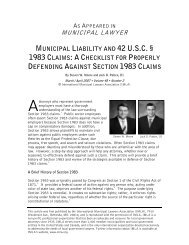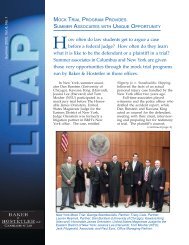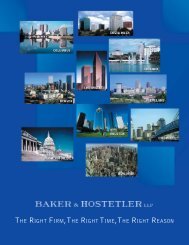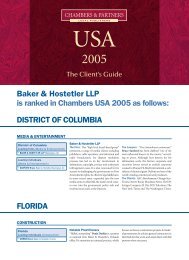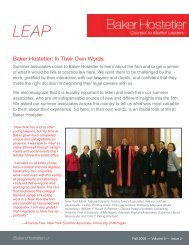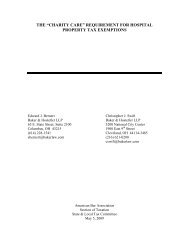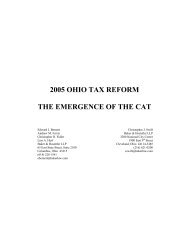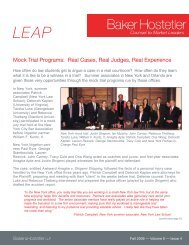Prejudgment Remedies in Texas - Doug D'Arche - Back to Main Page
Prejudgment Remedies in Texas - Doug D'Arche - Back to Main Page
Prejudgment Remedies in Texas - Doug D'Arche - Back to Main Page
- No tags were found...
Create successful ePaper yourself
Turn your PDF publications into a flip-book with our unique Google optimized e-Paper software.
Garnishee resides <strong>in</strong> another county, then the proceed<strong>in</strong>g must be transferred <strong>to</strong> the county ofthe Garnishee’s residence for trial. TEX. R. CIV. P. 675; Tex. Civ. Prac. & Rem. Code § 63.005;S.L. Crawford Const., Inc. v. Lassiter, 17 S.W.3d 379, 380-81 (Tex. App.—Hous<strong>to</strong>n [1 st Dist.]2000, no writ). There are three items required for the Garnishee <strong>to</strong> obta<strong>in</strong> a discharge. Rowleyv. Lake Area Nat. Bank, 976 S.W.2d 715, 720 (Tex. App.—Hous<strong>to</strong>n [1 st Dist.] 1998, writ denied).These three items are: (1) a denial that the garnishee is <strong>in</strong>debted <strong>to</strong> the defendant, (2) a denialthat the garnishee has effects of the defendant; and (3) a denial of knowledge of third personswho may be <strong>in</strong>debted <strong>to</strong> the defendant or have effects of the defendant, or the names of suchpersons. Id. If the Garnishee denies all these matters, and if Credi<strong>to</strong>r does not controvert thesematters with an affidavit, the Garnishee is discharged upon its answer. Tex. R. Civ. P. 666, 673;A. Wolfson's, Inc. v. First State Bank of Corpus Christi, 752 S.W.2d 614, 614 (Tex. App.—Corpus Christi 1988, writ denied). In that case, the Garnishee is entitled <strong>to</strong> recover the costs ofthe proceed<strong>in</strong>g, <strong>in</strong>clud<strong>in</strong>g reasonable compensation <strong>to</strong> the Garnishee, <strong>to</strong> be taxed as costs.Tex. R. Civ. P. 677.If the Garnishee's answer admits that the Garnishee is <strong>in</strong>debted <strong>to</strong> the Deb<strong>to</strong>r or haseffects belong<strong>in</strong>g <strong>to</strong> the Deb<strong>to</strong>r, then the judgment will be entered <strong>in</strong> accordance with theanswer of the Garnishee. Tex. R. Civ. P. 668, 669; Healy v. Wick Bldg. Systems, Inc., 560S.W.2d 713, 717 (Tex. Civ. App.—Dallas 1977, writ ref'd n.r.e.). The judgment should directthat the funds be deposited with the registry of the Court pend<strong>in</strong>g outcome of the underly<strong>in</strong>gdispute.If the Garnishee's answer raises doubts about the ownership of the funds, then theCredi<strong>to</strong>r must prove that the Deb<strong>to</strong>r owns the funds. Putman & Putman, Inc. v. Capi<strong>to</strong>lWarehouse, Inc., 775 S.W.2d 460, 463 (Tex. App.—Aust<strong>in</strong> 1989, writ denied). The Credi<strong>to</strong>r <strong>in</strong> agarnishment action merely steps <strong>in</strong><strong>to</strong> the shoes of the Deb<strong>to</strong>r, as aga<strong>in</strong>st the Garnishee.Rowley v. Lake Area Nat. Bank, 976 S.W.2d 715, 719 (Tex. App.—Hous<strong>to</strong>n [1 st Dist.] 1998, writdenied). The Credi<strong>to</strong>r may enforce whatever rights the Deb<strong>to</strong>r could have enforced had theDeb<strong>to</strong>r been su<strong>in</strong>g the Garnishee directly. Id.The f<strong>in</strong>al judgment <strong>in</strong> the garnishment proceed<strong>in</strong>g may not be entered until after entry ofa f<strong>in</strong>al judgment <strong>in</strong> the underly<strong>in</strong>g lawsuit. Glenn W. Casey Const., Inc. v. Citizens Nat. Bank,611 S.W.2d 695, 700 (Tex. Civ. App.—Tyler 1980, no writ); Southern Pipel<strong>in</strong>e Const. Co., Inc. v.Humble Oil Ref<strong>in</strong><strong>in</strong>g Co., 496 S.W.2d 248, 249 (Tex. Civ. App.—Hous<strong>to</strong>n [14 th Dist.] 1973, writref’d n.r.e.). For purposes of a garnishment proceed<strong>in</strong>g, a judgment is f<strong>in</strong>al upon sign<strong>in</strong>g, unlessa supersedeas bond is approved and filed. Thompson v. Harco Nat. Ins. Co., 997 S.W.2d 607,612 (Tex. App.—Dallas 1998, writ denied).B. SEQUESTRATION1. OverviewSequestration is an extraord<strong>in</strong>ary pre-judgment writ whereby property <strong>in</strong> dispute <strong>in</strong> alawsuit may be seized and held by the levy<strong>in</strong>g officer until it is sold, replevied or turned overas ordered by the Court. Sequestration proceed<strong>in</strong>gs are available when the suit is forpossession or foreclosure of property that is <strong>in</strong> immediate danger of be<strong>in</strong>g ill-treated,wasted, destroyed or concealed. This is the remedy that is commonly used by a Credi<strong>to</strong>rthat has title <strong>to</strong> property or a lien upon that property.Generally, under a Writ of Sequestration, the property is seized and preserved dur<strong>in</strong>gthe pendency of the lawsuit. Where the property is perishable, it may be sold prior <strong>to</strong> f<strong>in</strong>aljudgment. Sworn plead<strong>in</strong>gs and a bond are required. The Deb<strong>to</strong>r is required <strong>to</strong> be served withthe writ and has the opportunity <strong>to</strong> have the property returned dur<strong>in</strong>g pendency of the lawsuit by<strong>Page</strong> 14 of 36



